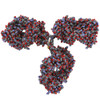Description
MOUSE ANTI-CANINE HEARTWORM ANTIBODY (3233)
Mouse Anti Canine Heartworm Antibody (3233) reacts with Dirofilaria immitis. The antibody is suitable for enzyme immunoassay (EIA) applications (ELISA).
PRODUCT DETAILS – MOUSE ANTI-CANINE HEARTWORM ANTIBODY (3233)
- Mouse Anti Canine Heartworm Antibody (3233).
- Reacts with Dirofilaria immitis. Negative for uninfected canine serum.
- Suitable for use in Sandwich ELISA.
- Purified by Protein G Sepharose chromatography. Greater than 90% pure.
- Presented in phosphate buffered saline, pH 7.2, 0.1% sodium azide.
BACKGROUND
Dirofilaria immitis is a parasitic nematode responsible of canine and feline cardiopulmonary dirofilariasis in both domestic and wild hosts, and the causal agent of human pulmonary dirofilariasis. It is a zoonotic parasitic disease transmitted by mosquitoes and mainly located in temperate, tropical, and subtropical areas of the world (Simón et al., 2009b). In the United States, canine dirofilariasis has been reported from all states, and D. tenuis in raccoons is common in many areas where raccoons are found. Canine and human dirofilariasis are most prevalent in eastern and southeastern states, although rates are increasing rapidly in a number of western states. D. immitis is the Dirofilaria species most commonly reported to cause dirofilariasis in humans in the United States. In Europe, Dirofilaria immitis is distributed mainly in the Mediterranean region, including Italy, Greece and Spain, whereas in northern European countries, D. repens is the Dirofilaria species most commonly reported to cause dirofilariasis among humans (CDC, 2019; Miterpáková et al., 2018).
Different species of culicid mosquitoes (Culex spp., Aedes spp., Anopheles spp.) act as an intermediate stage in order to complete their life cycle. In a canine host, sexually mature worms produce microfilariae that circulate in the blood and are ingested by mosquitoes during a blood meal. In mosquitoes, the microfilariae develop into larvae that migrate to the proboscis where they are ready to infect another host during a blood meal. Heartworms typically live for 3–5 years in an animal’s body. At least 70 species of mosquitoes can transmit heartworm disease, including Aedes, Anopheles, Culex and Mansonia (Atkins, 2019).
Diagnosis of heartworm infection relies upon detecting antigen of Dirofilaria immitis in serum, plasma, or whole blood samples. ELISA is considered the most sensitive platform and detects antigen in as many as 85.7% of dogs infected with a single adult female worm; reported sensitivity for microtiter plate ELISA when at least 3 adult female worms are present is 100% (McCall, 2001). Many of the lateral flow immunochromatographic assays and the membrane-bound ELISAs, which are designed to provide rapid in-clinic results, also demonstrate good sensitivity and can detect antigen in 46–76.2% of patients infected with a single female worm and 84–100% of patients with 3 or more female worms [McCall, 2001; Courtney and Zeng, 2001; Atkins, 2003).
REFERENCES
- Atkins CE. (2003). Comparison of results of three commercial heartworm antigen test kits in dogs with low heartworm burdens. J Am Vet Med Assoc. 222(9):1221-3.
- Atkins C. (2019). Heartworm Disease in Dogs. Merck Sharp & Dohme Corp (MSD) Veterinary Manual.
- Courtney and Zeng (2001). Comparison of heartworm antigen test kit performance in dogs having low heartworm burdens. Vet Parasitol. 2001 Apr 19; 96(4):317-22.
- Parasites factsheet. Centers for Disease Control and Prevention (CDC), Global Health, Division of Parasitic Diseases. July 3, 2019.
- McCall JW, Suprakorndej BS, Donoghue AR, Turnbull RK. Evaluation of the performance of canine heartworm antigen test kits licensed for use by veterinarians and canine heartworm antigen tests conducted by diagnostic laboratories. In: Seward LE, Knight DH, editors. Recent Advances in Heartworm Disease Symposium ’01. Batavia, Illinois: American Heartworm Society; 2001. pp. 135–140.
- Miterpáková et al. (2018). Heartworm on the rise-new insights into Dirofilaria immitis epidemiology. Parasitol Res. 117(7):2347-2350.
- Simón et al. (2009b). What is new about animal and human dirofilariosis? Trends Parasitol. 25, 404–49910.












